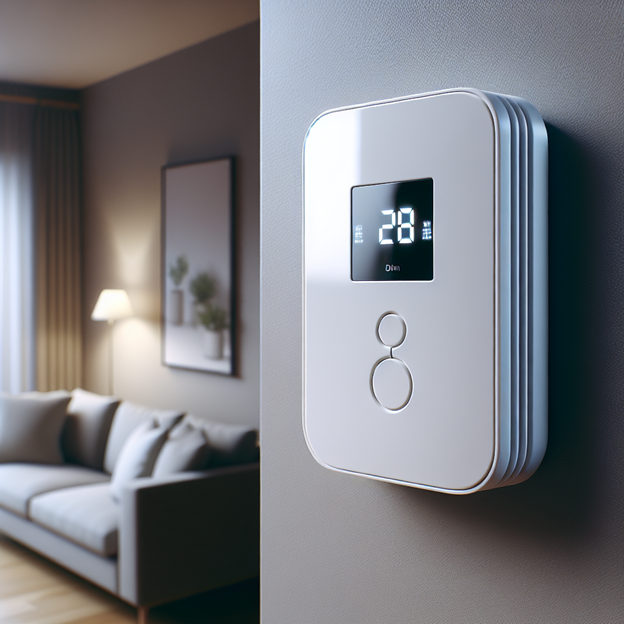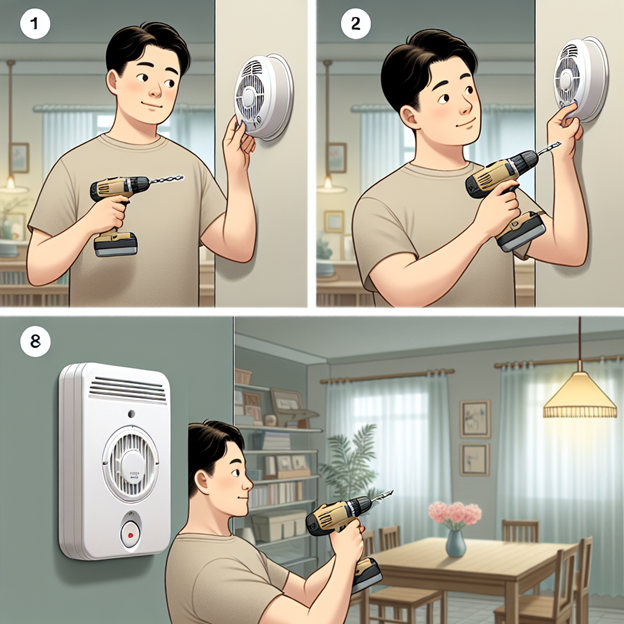
Your Carbon Monoxide Detector: Philosophies and Tips to Deal With it
Carbon monoxide (CO) is usually referred to as the “silent killer” as a result of it’s not possible to smell, style and see this toxic gas. It is a gas that results when fossil fuels like coal, oil, natural gas and wood are burned incompletely.
An automatic mechanism such as a carbon monoxide detector is necessary to make sure you are warned of the presence of this deadly gas, which could save life if detected.
In this comprehensive guide, you will learn why carbon monoxide detectors are necessary, how to install them in your home properly, whack a detector experiencing maintenance issues, and take care of one along with the longevity you can expect out of it.
What is Carbon Monoxide and Why is Detection Important?
Risks Related to Exposure to Carbon Monoxide
Symptoms of carbon monoxide exposure can range from headaches and dizziness to unconsciousness and death. If CO is inhaled, it attaches to the hemoglobin in our blood and prevents O2 from reaching cells, tissues, and organs. For this reason, it is important to have carbon monoxide alarms that work in your home to alert you if carbon monoxide levels are too high.
Carbon Monoxide Detectors Work

The CO detector has a sensor that detects harmful carbon monoxide emitted from the car. You will receive a warning beep to notify you when the saturation levels hit dangerous points. The detectors are designed to respond in the same amount of time that a person’s body would take to react, with the goal of aggressive notification so actions can be taken to hopefully prevent carbon monoxide poisoning.
Putting in a Carbon Monoxide Detector
Choosing the Right Detector for Your Home
When shopping for a carbon monoxide detector, you will want to carefully choose the type of monitor that is best suited to your needs. They come as battery-operated, plug-in, and hardwired in bulb even fixtures. These are specialized racks and each type has its advantages with some being quick to install and others good for power-outage reliability.
The Different Carbon Monoxide Detectors
Battery-Powered Detectors
These are portable and can be placed anywhere in the home, providing versatility. They need to be tested for the battery regularly.
Plug-In Detectors
These detectors are simple to use and come with a battery back-up which activates in case of power failure.
Hardwired Detectors
Most hardwired detectors also do not require you to change the power source of your home (some can use batteries).
Proper Installation Locations
The most efficient detection of explosives requires assuming with an adequate test that the detector in question will be positioned correctly. Place detectors inside your home on every level, & especially in the vicinity of bedtime. However, do not put them directly under appliances or this will cause false alarms.
Bad-Installer-Dont`s
Placement from Fuel-Burning Appliances
Place alarms at least 15-20 feet away from fuel-burning appliances to reduce false alarms.
Hanging Height
Being CO is about the same weight as air, detectors should be hung at eye level where they can take accurate readings.
Tip 1 Avoid Dead Air Spaces
Do not place detectors in corners or close to windows where airflow can disrupt the ability of the unit to detect CO.

Troubleshooting Common Issues
Why is my Carbon Monoxide Detector beeping?
A carbon monoxide detector beeps so, when detecting CO hue, provides a sound alert with the load of that alert depending upon how high the concentration associated with CO raises. Take the time to listen, as understanding those sounds can help you answer accordingly.
Different types of Alarm Sound
Never-ending Beep
This means that your CO detector is reading the level of co in the house: you need to wake up and evacuate and call an emergency right then!
Help
Frequent chirps are often the result of a low battery and/or the end of the life of your detector.
How to Stop False Alarms
Humidity and dust can often lead to your detector beeping without any CO present. Silence the alarm momentarily by pre… and refer to the manual for more info.
When to Reset Carbon Monoxide Tester
It is very important to know when it is time to reset a carbon monoxide alarm, in order to ensure that the home you are living in does not contain any dangerous levels of this deadly gas. If your Carbon Monoxide CO alarm is beeping every 30 seconds it may need a reset.
This usually means that the alarm was caused by a legitimate source, like a furnace malfunction or gas leak. Get rid of the carbon monoxide you introduced, then change those batteries and more importantly replace that CO alarm if it is old (over ten years) or damaged.
It’s also a good idea to change the batteries in your combination alarms, many of which double as smoke detectors, at least every six months. The alarm will chirp every 5 minutes in the event of a low battery which has limited or no back-up power available. You must always see its longevity and integration within the tech user guide of your device by referring to warranty, manufacturer’s guideline, etc.
It will also flash if you REPLACE UNIT and will have a single beep every 30 to 60 seconds; whereas, one every 5 seconds signals that you need to replace the unit. The alarm should be easily reachable to you; mount the alarm on the ceiling or high up on a wall in your bedroom for maximum benefit.
Now keep in mind, one of the best solutions for your safety is to be actively tracking your alarms, and responding quickly as with any notifications. Keep in mind, though, that if you continue to experience problems, you should consult a certified technician for an evaluation of your electronics and heating systems. The best preventative measures for carbon monoxide hazards are regular maintenance and education.
How to Reset (And Test) A Carbon Monoxide Alarm
When you are trying to reset a carbon monoxide alarm, first make sure the cause of the alarm is taken care of. If the alarm beeping continues, use your fingers to find a reset button on the front or side of the detector.
Keep holding the button until a beep is heard, that means the alarm has been reset. You should also run an alarm test to see whether or not it does whatever it is supposed to. You can do this by hitting the test button, at which point a loud beep should be heard if the alarm works the way it should.
Secure your house against carbon monoxide. Inspect your carbon monoxide gas alarm system every 40 days to see if it is functioning properly. And, you may want to change the battery every six months or whenever the alarm beeps low battery (usually a chirping noise) Nest Protect avoids false alarms by having its alarm be placed in a proper location, ten feet away from fuel-burning appliances.
Battery and Power Issues
Testing and Replacing Batteries
Keep batteries of the detector in check at least once a week; replace if needed, and adjust SAT into alternate mode. When it beeps every minute, this means the battery is dying.
Solving Power Supply Problems
If you have a plug-in or hardwired detector, make sure it is wired into a always-on outlet. If the unit does not power on, check the power source and try contacting a technician if the problem still exists.
Maintenance And Testing on a Regular Basis
Frequency of Testing Your Detector
Monthly testing of your carbon monoxide detector will make sure that it works properly. To ensure the unit is operational all you need to do is press a “test” button and see if an alarm rings.
Cleaning and Maintenance Tips
You can clean your detector by using a vacuum cleaner with a nozzle around the sensor and vents. Do not apply any cleaning agents as these may damage the sensor.
How to make sure your detector will last
Dust it regularly and replace it at least once every 7-to-10-years to avoid the degradation of hardware.
Wellbeing Tip: When to Replace Your Carbon Monoxide Detector
Understanding End of Life Signals
Sensors will sound a particular audio sequence official sound to warn the detector of benefits_command_useful_life. And that’s a safety mechanism of your residence too.
Replacement Detector Selection
When swapping out your detector, have a look at new ones that include features like a digital readout displaying current CO levels and peak memory to store past instances of CO exposure.
Conclusion
Maintaining your Carbon Monoxide detectors and replacing those when necessary is key to staying safe in the home. By sticking to these tips you can avoid CO poisoning and ensure the safety of your friends and family.
FAQs
What if my carbon monoxide alarm goes off?
Move into fresh air outside or by an open window and call emergency services. Wait until you have been instructed that the coast is clear, and then re-enter.
When will the carbon monoxide detector batteries be replaced?
Battery replacements yearly or that activate the low battery chirp
Do you also need a natural gas leak detector to work your carbon monoxide detector?
Be warned: CO detectors are just that, exclusively for carbon monoxide. This is a good solution, but you really should have the combined unit or at least an additional natural gas detector on site for a more complete coverage.
Our goal is to provide ways for you to enhance your home safety routine so that you can better maintain and trust your carbon monoxide detectors, which in turn can keep you safeguarded against potential CO threats within the household.

Hello Readers! I’m Mr. Sum, a tech-focused content writer, who actively tracks trending topics to bring readers the latest insights. From innovative gadgets to breakthrough technology, my articles aim to keep audiences informed and excited about what’s new in tech.